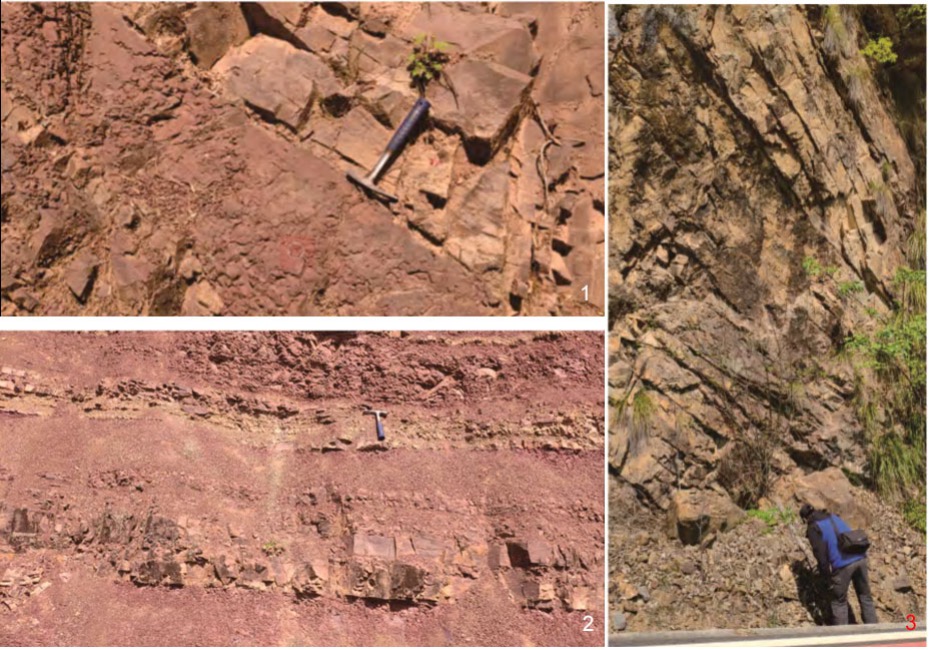Jükeng Fm
Period:
Silurian
Age Interval:
late Aeronian to Telychian (S1) (64)
Province:
Anhui
Type Locality and Naming
It was named as Taiping Group in 1974 by the Regional Geological Survey of Anhui Geological Bureau. The type section is at Jükeng of Xianyuan Town, Huangshan City (118°13'24.3″E, 30°20'46.3″N). The Taiping Group was abandoned for the homonym with one of the units of Ordovician. The authors accepted the definition of Jükeng Fm revised by Rong et al. (2023).
Synonym: Jukeng Fm; 举坑组
Lithology and Thickness
The formation, over 2200 m thick, consists of 3 members, i.e., the Lower Member, 1155m in thickness, consists of the purple intercalated with yellowish green clastic rocks, represents of the first set of red beds of Silurian; the Middle member is 743m in thickness, consists of greyish/ yellowish green, white, dark grey fine grain quartz sandstone, siltstone and silty mudstone, without purple clastic rocks interbeds; the Upper Member consists of two parts, of which the lower part is made up by 159m thick purple medium-thick bedded siltstone intercalated with muddy siltstone, represents of the second set of red beds of Silurian; the upper part is 152m thick greyish white or dark grey fine grain sandstone intercalated with siltstone and mudstone (Figure).
[Figure the outcrops of Jükeng Fm at the type locality (Photography from Rong et al.,2023)]
Lithology Pattern:
Clayey sandstone
Relationships and Distribution
Lower contact
It is conformable contacted with the underlying Helixi Formation
Upper contact
It’s unconformable overlain by the Wutong Fm of Devonian.
Regional extent
It is exposed around the border area of Jiangsu, Anhui and Zhejiang provinces. The thickness of the formation in Xuancheng-Ningguo areas of Southern Anhui is over 2000m, quite similar with the type locality and its adjacent areas. The thickness is decreased remarkably to less than 400m un Longmengling area, Huangshan District; less than 600 m in Helixi, Fancun areas of NIngguo Xian, Tangxin area of Guangde City.
GeoJSON
null
Fossils
It yields chitinozoan Eisenachitina venusta Tsegelnjuk in the Upper Member, and Grahnichitina sp., Angochitina sp., Sphaerochitina sp., Angochitina cf. longicollis Eisenack and Conochitina cf. gunriveris Soufiane et Achab in the Middle Member of Jükeng Fm.
Age
Based on a comprehensive analysis of the fossils from the Tangchiawu Fm, Kangshan Fm and Jukeng Fm along with their underlying strata (the Dabaidi Fm and Helixi Fm with non-purplish red clastic rocks), Rong et al. (2023) considered that the lower boundaries of the Tangchiawu Fm, Kangshan Fm and Jukeng Fm formations are of late Aeronian, Llandovery in age. The development of the marine red beds was strongly controlled by the expansion and uplift of the Cathaysian Oldland. According to the Palaeogeographical pattern proposed by Rong et al. (2023), the Tangchiawu Fm is closest to the Cathaysian Oldland, followed by the Kangshan Fm in northwestern Zhejiang Fm and Jukeng Fm in southern Anhui Province. The closer to Cathaysian Oldland, the more denudation and the less the Silurian remained, such as the Tangchiawu Fm. On the contrary, was the typical Jukeng Fm.
Age Span:
Beginning stage:
Aeronian
Fraction up in beginning stage:
0.8
Beginning date (Ma):
438.97
Ending stage:
Telychian
Fraction up in the ending stage:
0.8
Ending date (Ma):
434.06
Depositional setting
Depositional pattern:
Additional Information
Compiler:
Wang Chuanshang and Wang Xiaofeng
